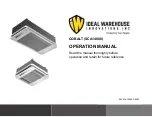
30-EN
29-EN
– 15 –
How to open the valve
Fully open the valves of the outdoor unit. (First fully
open the valve on the liquid side, and then fully open
the valve on the gas side.)
* Do not open or close the valves when the ambient
temperature is -20°C or less. Doing so may damage
the valve O-rings and result in refrigerant leakage.
Liquid side, gas side
Open the valve with hexagon wrench.
[Hexagonal wrench is required.]
Hexagonal wrench size
Liquid side
Gas side
GM56
4 mm
4 mm
GM80
4 mm
5 mm
Valve handling precautions
y
Open the valve stem until it strikes the stopper.
It is unnecessary to apply further force.
y
Securely tighten the cap with a torque wrench.
Cap tightening torque
Valve size
Ø6.4 mm
14 to 18 N•m
(1.4 to 1.8 kgf•m)
Ø9.5 mm
14 to 18 N•m
(1.4 to 1.8 kgf•m)
Ø12.7 mm
33 to 42 N•m
(3.3 to 4.2 kgf•m)
Ø15.9 mm
33 to 42 N•m
(3.3 to 4.2 kgf•m)
Charge port
14 to 18 N•m
(1.4 to 1.8 kgf•m)
Replenishing refrigerant
This model is a 20 m chargeless type that does not
need to have its refrigerant replenished for refrigerant
pipes up to 20 m. When a refrigerant pipe longer than
20 m is used, add the speci
fi
ed amount of refrigerant.
Refrigerant replenishing procedure
1. After vacuuming the refrigerant pipe, close the
valves and then charge the refrigerant while the air
conditioner is not working.
2. When the refrigerant cannot be charged to the
speci
fi
ed amount, charge the required amount of
refrigerant from the charge port of the valve on the
gas side during cooling.
Requirement for replenishing refrigerant
Replenish liquid refrigerant.
When gaseous refrigerant is replenished, the
refrigerant composition varies, which disables normal
operation.
Air purge
With respect to the preservation of the terrestrial
environment, adopt “Vacuum pump” to purge air
(Evacuate air in the connecting pipes) when installing
the unit.
y
Do not discharge the refrigerant gas to the
atmosphere to preserve the terrestrial environment.
y
Use a vacuum pump to discharge the air (nitrogen,
etc.) that remains in the set. If air remains, the
capacity may decrease.
For the vacuum pump, be sure to use one with a
back
fl
ow preventer so that the oil in the pump does not
back
fl
ow into the pipe of the air conditioner when the
pump stops.
(If oil in the vacuum pump is put in an air conditioner
including R32/R410A, it may cause trouble with the
refrigeration cycle.)
Compound pressure gauge
Pressure gauge
Gauge manifold
valve
Handle High
(Keep fully closed)
Charge hose
(For R32/R410A)
Vacuum pump adapter
for counter
fl
ow
prevention
(For R32/R410A)
Vacuum
pump
Charge port
(Valve core
(Setting pin))
Charge hose
(For R32/R410A)
Handle Low
–101 kPa
(–76 cmHg)
Packed valve at gas side
Vacuum pump
As shown in the
fi
gure, connect the charge hose after
the manifold valve is closed completely.
↓
Attach the connecting port of the charge hose with a
projection to push the valve core (setting pin) to the
charge port of the set.
↓
Open Handle Low fully.
↓
Turn ON the vacuum pump. (*1)
↓
Loosen the
fl
are nut of the packed valve (Gas side)
a little to check that the air passes through. (*2)
↓
Retighten the
fl
are nut.
↓
Execute vacuuming until the compound pressure gauge
indicates –101 kPa (–76 cmHg). (*1)
↓
Close Handle Low completely.
↓
Turn OFF the vacuum pump.
↓
Leave the vacuum pump as it is for 1 or 2 minutes, and
check that the indicator of the compound pressure gauge
does not return.
↓
Open the valve stem or valve handle fully.
(First, at liquid side, then gas side)
↓
Disconnect the charge hose from the charge port.
↓
Tighten the valve and caps of the charge port securely.
*1: Use the vacuum pump, vacuum pump adapter, and gauge
manifold correctly referring to the manuals supplied with
each tool before using them.
Check that the vacuum pump oil is
fi
lled up to the speci
fi
ed
line of the oil gauge.
*2: When air is not charged, check again whether the
connecting port of the discharge hose, which has a
projection to push the valve core, is
fi
rmly connected to the
charge port.












































